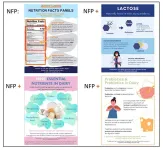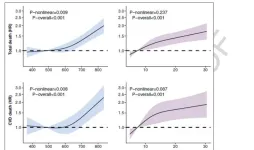(Press-News.org) Philadelphia, February 28, 2024 – Although most Americans consume dairy and many dairy foods are rising in popularity, fluid milk consumption has seen a significant decline among US consumers since the 1960s. To reverse this trend—and ensure consumers are getting adequate amounts of dairy in their diets—the dairy sector has developed educational materials to reach consumers through informational infographics and TV and print ads, and on social media. But do these kinds of educational messages move the needle? A new study in JDS Communications, published by the American Dairy Science Association and Elsevier, demonstrates that when consumers are empowered with the facts on dairy’s nutritional benefits, they buy and consume more dairy products—including cheese, ice cream, yogurt, and especially milk.
Lead investigator Stephanie Clark, PhD, who recently retired from the Department of Food Science and Human Nutrition, Iowa State University, explained, “We set out to educate those who consume an inadequate amount of dairy (less than three servings of dairy per day, according to The Dietary Guidelines for Americans) about various topics related to dairy nutrition, test their retention of information, and if increasing their knowledge around dairy motivates purchasing and consumption of dairy products.”
Clark and the research team conducted their study in three phases: a screening survey, nominal focus groups, and a final follow-up survey with voluntary adult participants. In the first phase, a total of 4,542 adults completed the team’s 15-question screening survey.
Clark outlined, “After the initial screening survey was closed, we funneled out a group of 195 participants for the nominal focus groups based on their interest in participating, lack of any food allergies, and the fact that they were reporting consuming less than three servings of dairy per day.”
Four infographics were developed to help educate research participants about food labels and dairy concepts: nutrition facts panels, lactose maldigestion, nine essential nutrients, and prebiotics and probiotics.
During the nominal focus groups phase, facilitators administered a pre-survey to the participants, then walked them through the infographics lesson, before administering an ice cream acceptability test. Three samples of ice cream were tasted, and the facilitators explained the nutrition facts panels and ingredient statements of each, with attention given to the differences in lactose and added sugar among the samples.
Clark noted, “Unlike traditional focus groups, where data are collected from interacting panelists, our goal with the nominal format—involving limited interactions between participants—was to deliver educational information to the participants efficiently.”
After the ice cream test, participants received a post-survey and another survey one month later.
The study results show that attending the nominal focus groups had a significant and positive effect on dairy product purchasing and consumption between the pre-survey and the one-month follow-up survey.
Clark elaborated, “Average dairy product purchasing increased to 4.4 servings per week, a 26% increase. Average consumption of each dairy product also increased—23% for cheese, 20% for ice cream, 26% for yogurt, and a staggering 53% increase for milk.”
In total, overall participant dairy consumption rose to eight servings per week, or a 35% jump.
“The result for milk consumption was the stand-out in our results, with every focus group seeing milk consumption go up by at least one serving per week.”
Despite these positive results, the research team was quick to point out that participants did not reach the recommended 21 servings of dairy per week. They stressed the importance of additional research to understand the long-term impacts of education on dairy in the diet, or if improvements to the educational materials or delivery might enhance their impact.
Overall, this study demonstrates that carefully constructed educational messages on the benefits and nutritional attributes of dairy foods can positively influence consumer behavior, leading to increased purchasing and consumption of dairy foods.
END
Consumers empowered with the facts on dairy’s nutritional benefits buy and consume more dairy foods
Participants in a JDS Communications® study increased their purchasing and consumption of cheese, ice cream, milk, and yogurt by more than 20% after learning more about dairy nutrition
2024-02-28
ELSE PRESS RELEASES FROM THIS DATE:
How air pollution can harm team performance
2024-02-28
High levels of air pollution can harm performance of teams, which are vital for solving complex problems such as developing clean energy technologies and vaccines, and this could harm economic development in highly polluted emerging economies, says a new study co-authored at Cambridge Judge Business School.
The study used data from 15,000 live escape-room games in London. It estimated based on the data and the study’s equations that for about 3,500 teams that participated for team-building exercises (usually from a corporate ...
Online toxicity can only be countered by humans and machines working together, according to Concordia researchers
2024-02-28
Wading through the staggering amount of social media content being produced every second to find the nastiest bits is no task for humans alone.
Even with the newest deep-learning tools at their disposal, the employees who identify and review problematic posts can be overwhelmed and often traumatized by what they encounter every day. Gig-working annotators, who analyze and label data to help improve machine learning, can be paid pennies per unit worked.
In a new Concordia-led paper published in IEEE Technology and Society Magazine, researchers argue that supporting ...
SwRI sponsors Future Leaders Program at 2024 ITS America Conference & Expo
2024-02-28
SAN ANTONIO– February 28, 2024 – Southwest Research Institute (SwRI) and ITS Arizona are inviting college students to participate in the Future Leaders Program at this year’s ITS America Conference & Expo, April 22-25, at the Phoenix Convention Center.
The Future Leaders Program allows the next generation of intelligent transportation systems (ITS) leaders to attend education sessions and meet with exhibitors, sponsors and technology providers, all while networking with ITS professionals who can offer career advice and mentorship.
“The ITS industry is continuously looking for smart and creative people to ...
New LOINC® semiannual release highlights health equity work with national and international partners
2024-02-28
LOINC® from Regenstrief Institute’s semiannual content update highlights the comprehensive nature of its work with international partners, including supporting interoperability for prescription drug records, reporting notifiable conditions and standardizing social risk screening tools to represent social determinants of health (SDOH) information in electronic health records (EHRs).
LOINC release 2.77 includes more than 800 new concepts and edits to more than 1,500 concepts. Work captured in the new release includes support for molecular genetic drug and toxicology ...
New study unveils scalable and efficient photoelectrode modules for green hydrogen production
2024-02-28
In a groundbreaking development towards practical photoelectrochemical water splitting, a research team in the School of Energy and Chemical Engineering at UNIST, led by Professors Jae Sung Lee, Ji-Wook Jang, and Sang Il Seok, in collaboration with Professor Hankwon Lim from the Graduate School of Carbon Neutrality at UNIST, has achieved a remarkable technological breakthrough in the production of green hydrogen. Through their innovative approach, the team has overcome the challenges of efficiency, stability, and scalability in photoelectrodes, paving the way for ...
Sedentary behavior increases mortality risk
2024-02-28
Based on decades-long observations of centenarians, author Dan Buettner (Blue Zones) conjectures that people live longer when they get up and move around after sitting for twenty minutes. Now, a rigorous new study published in the Journal of the American Heart Association (JAHA) has data showing that older women who sat for 11.7 hours or more per day increased their risk of death by 30 percent, regardless of whether they exercised vigorously.
Study co-author Steve Nguyen, Ph.D., M.P.H., a postdoctoral fellow at the University of California San Diego Herbert Wertheim School of Public Health and Human Longevity Science, ...
New approach may prevent deadly intestinal disease in preemies
2024-02-28
Scientists from Stanley Manne Children’s Research Institute at Ann & Robert H. Lurie Children’s Hospital of Chicago and colleagues found that an investigational protein replacement – recombinant human insulin-like growth factor 1 and its binding protein-3 (rhIGF-1/BP3) – protected neonatal mice from necrotizing enterocolitis (NEC), a deadly intestinal disease that often strikes extremely premature infants. Results were published in the journal Pediatric Research.
“Our preclinical evidence is encouraging and paves the way to a clinical trial of rhIGF-1/BP3 for prevention of NEC,” said senior author Isabelle De Plaen, MD, a scientist ...
Endocrine Society supports federal legislation protecting IVF access
2024-02-28
WASHINGTON—The Endocrine Society is calling for members of Congress to support federal legislation protecting access to in vitro fertilization (IVF).
The Access to Family Building Act (S.3612/H.R.7056), proposed by Sens. Tammy Duckworth (D-IL), Patty Murray (D-WA), and Rep. Susan Wild (D-PA), would ensure people can access safe, effective IVF and other assisted reproductive technologies to start or grow their families.
Families’ access to IVF services is being threatened by an Alabama State Supreme Court ruling that frozen embryos ...
World’s first metamaterial developed to enable real-time shape and property control
2024-02-28
Inspired by the remarkable adaptability observed in biological organisms like the octopus, a breakthrough has been achieved soft machines. A research team, led by Professor Jiyun Kim in the Department of Materials Science and Engineering at UNIST has successfully developed an encodable multifunctional material that can dynamically tune its shape and mechanical properties in real-time. This groundbreaking metamaterial surpasses the limitations of existing materials, opening up new possibilities for applications in robotics and other fields requiring adaptability.
Current soft machines lack the level of adaptability demonstrated by their ...
Pancreatic cancer lives on mucus
2024-02-28
Knowing exactly what’s inside a tumor can maximize our ability to fight cancer. But that knowledge doesn’t come easy. Tumors are clusters of constantly changing cancer cells. Some become common cancer variants. Others morph into deadlier, drug-resistant varieties. No one truly understands what governs this chaotic behavior.
Now, Cold Spring Harbor Laboratory (CSHL) Professor David Tuveson and his team have uncovered a mechanism involved in pancreatic cancer transformation—mucus. During the disease’s early stage, pancreatic cancer cells produce mucus. Additionally, these cells depend on the body’s regulators of mucus production. This new ...
LAST 30 PRESS RELEASES:
Air pollution exposure and birth weight
Obstructive sleep apnea risk and mental health conditions among older adults
How talking slows eye movements behind the wheel
The Ceramic Society of Japan’s Oxoate Ceramics Research Association launches new international book project
Heart-brain connection: international study reveals the role of the vagus nerve in keeping the heart young
Researchers identify Rb1 as a predictive biomarker for a new therapeutic strategy in some breast cancers
Survey reveals ethical gaps slowing AI adoption in pediatric surgery
Stimulant ADHD medications work differently than thought
AI overestimates how smart people are, according to HSE economists
HSE researchers create genome-wide map of quadruplexes
Scientists boost cell "powerhouses" to burn more calories
Automatic label checking: The missing step in making reliable medical AI
Low daily alcohol intake linked to 50% heightened mouth cancer risk in India
American Meteorological Society announces Rick Spinrad as 2026 President-Elect
Biomass-based carbon capture spotlighted in newly released global climate webinar recording
Illuminating invisible nano pollutants: advanced bioimaging tracks the full journey of emerging nanoscale contaminants in living systems
How does age affect recovery from spinal cord injury?
Novel AI tool offers prognosis for patients with head and neck cancer
Fathers’ microplastic exposure tied to their children’s metabolic problems
Research validates laboratory model for studying high-grade serous ovarian cancer
SIR 2026 delivers transformative breakthroughs in minimally invasive medicine to improve patient care
Stem Cell Reports most downloaded papers of 2025 highlight the breadth and impact of stem cell research
Oxford-led study estimates NHS spends around 3% of its primary and secondary care budget on the health impacts of heat and cold in England
A researcher’s long quest leads to a smart composite breakthrough
Urban wild bees act as “microbial sensors” of city health.
New study finds where you live affects recovery after a hip fracture
Forecasting the impact of fully automated vehicle adoption on US road traffic injuries
Alcohol-related hospitalizations from 2016 to 2022
Semaglutide and hospitalizations in patients with obesity and established cardiovascular disease
Researchers ‘listen in’ to embryo-mother interactions during implantation using a culture system replicating the womb lining
[Press-News.org] Consumers empowered with the facts on dairy’s nutritional benefits buy and consume more dairy foodsParticipants in a JDS Communications® study increased their purchasing and consumption of cheese, ice cream, milk, and yogurt by more than 20% after learning more about dairy nutrition







